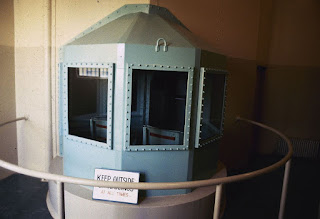First use of gas chamber in California
by Robert A. Waters
In PEOPLE vs. Eudy, the California Supreme Court summarized an attempted breakout at Folsom Prison: "The crime of which the defendants stand convicted was committed on September 19, 1937. All of them were then inmates of Folsom state prison. Clarence Larkin, the warden of the institution was in his office, located just off the prison yard, for the purpose of interviewing the prisoners who wished to see him. Each convict waiting to see the warden was allowed to enter this office as his turn came.
"When the defendant Eudy entered, six other convicts bearing knives and a pistol rushed into the office from the yard. They overpowered the warden and the captain of the guard, who were both unarmed, and marched them into the yard as hostages in an attempt to escape. There two of the convicts were shot and killed by guards in towers on the prison wall. Warden Larkin was then fatally stabbed by the five remaining prisoners; and in a melee between guards and prisoners, in which the latter were subdued, a guard also received injuries from which he died."
Larkin, stabbed 12 times, survived for five days before succumbing. Prison guard Harry M. Martin was stabbed to death. Yard Captain William J. Ryan, who rushed to aid Larkin, was stabbed numerous times, but survived.
The two inmates shot and killed during the attempted breakout were notorious San Francisco bank robber Clyde Stevens and a Los Angeles thief named Bennie Kucharsky. Both had previously served multiple terms in prisons across the state.
The following inmates were later tried, convicted, and sentenced to death: Albert Kessel, Robert Cannon, Wesley Eudy, Fred Barnes, and Ed Davis.
In the early 1930s, there was a push to replace the practice of hanging in California with a more "humane" way of executing criminals. Since several western states had begun using the gas chamber, California legislators decided that would be an appropriate death-dealing method. The murderers of Warden Larkin would be the first inmates to die in California's gas chamber.
On the morning of December 1, 1938, at San Quentin Prison, Albert Kessel and Robert Lee Cannon took their final walk.
Kessel, a former cohort of Clyde Stevens, had been convicted of three bank heists and sentenced to 40 years to life. Dragged into the chamber by guards, the terrified killer refused to look up. Spectators said he was holding a rosary and seemed to be praying. When the new warden released cyanide from bags located above the prisoners, Kessel attempted to hold his breath. The cyanide dropped into "acid pots," causing poisonous fumes to fill the air. According to the Oakland Tribune, "faint wisps of smoke floated upward from the acid pots like the smoke of a dying cigar. Higher and higher they rose until they reached the faces of the two men." Kessel lasted for about a minute, then his head dropped and he gasped. The killer twitched, then fell unconscious.
Robert Lee Cannon, originally from Tennessee, had begun his long criminal career as a car thief and graduated to bank robbery. The Tribune reported that "Cannon's head went back in a convulsive gesture. The...smile on his face turned into a gasp of horror and his lips formed words. To the tense spectators outside, the last words that passed from his lips appeared to be: 'It's bad! It's terrible.'"
Fifteen minutes after they first entered the chamber, the killers were pronounced dead.
Newspapers reported that prison officials hated the new method of execution. Prison Physician Dr. L. L. Stanley told newsmen that "hanging is simpler and quicker." Dr. J. C. Geiger, San Francisco health director, viewed the execution and stated, "The theory of instant death is hooey."
On December 9, Wesley Eudy and Fred Barnes, labeled by the press as "incorrigible," were next. With 99 witnesses, the two inmates walked into the chamber holding rosaries and praying. The San Mateo Times reported that "Eudys' and Barnes' hands clenched and their faces convulsed as guards quickly strapped their chests, ankles, arms, hands and legs to the back of two adjoining chairs." This time, no was smoke visible. The Times reported that "Barnes coughed violently. His eyes closed momentarily, and his head dropped to his chest. Eudy gasped and choked" before dying.
The final inmate from the Folsom uprising to die was 88-year-old Ed Davis. The week before his execution, he wrote a letter exonerating an innocent man. Walter Philpot had been convicted of participating in the 1933 robbery of the First National Bank of Clinton, Oklahoma, in 1933. Davis named four other men as his accomplices, claiming he had never met Philpot.
Called a "long-time Oklahoma desperado," Davis wrote a note to the prison warden. In it, he stated that " I never have and not now [will] ask mercy from God or man." Called "The Fox" and "The Phantom," Davis's criminal career began at 19. An old-line bank robber, he ran with Pretty Boy Floyd and other southwestern gangsters. In fact, he was often the brains behind many successful heists, but he laid low and let others do the actual robberies. Suspected of several murders, including that of an Oklahoma sheriff, Davis was a hardened desperado.
On December 16, he walked into the gas chamber, seeming without trepidation. Ten minutes later, the last participant in the Folsom escape attempt was dead.
Warden Larkin may have given his life to save others. As the seven prisoners marched him outside, he yelled to the guards not to open the gate. At that time, the enraged prisoners began stabbing him. Had these desperate prisoners escaped, many innocent lives might have been put in jeopardy.
While much of the focus during the aftermath of the escape attempt was on the prisoners, Warden Clarence Larkin, Yard Captain William J. Ryan, and guard Harry M. Martin were true heroes.



No comments:
Post a Comment